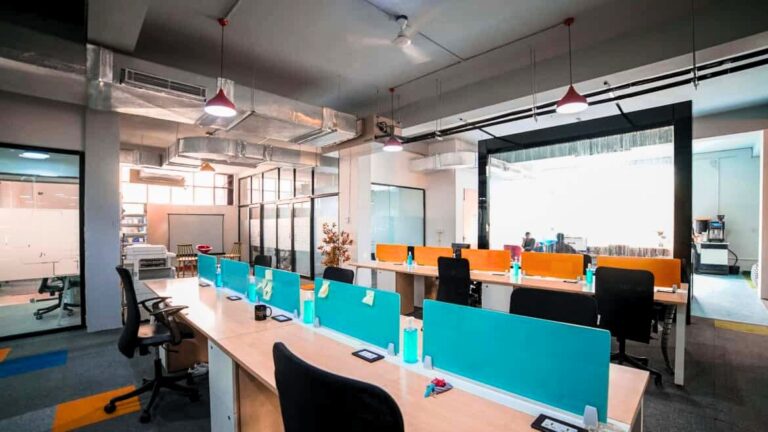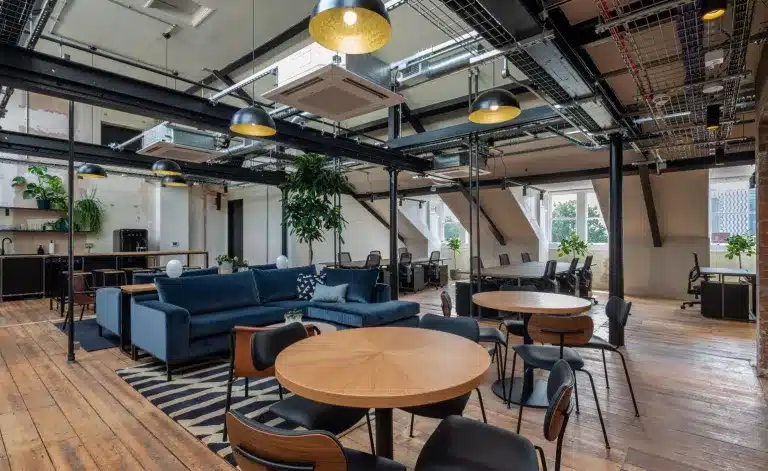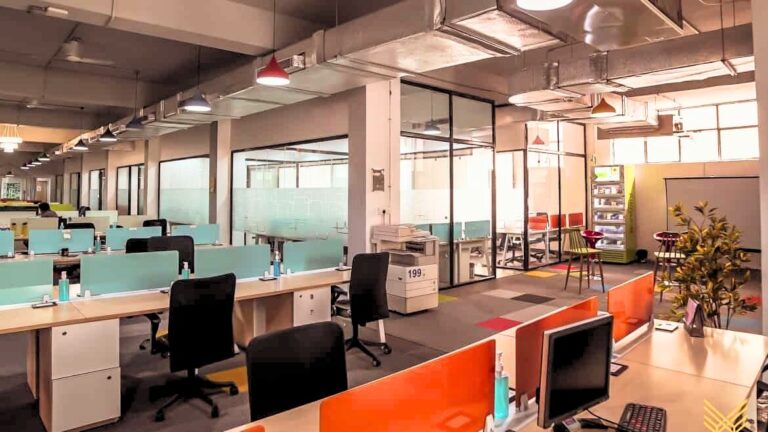Hybrid Workplace Design Explained
Imagine a workplace where you have the flexibility to work both from an office desk and the comfort of your home. That’s the essence of Hybrid Office Design. In this article, we’ll explain the concept of Hybrid Office Design in the simplest terms. We’ll explore how this innovative approach to workspaces is reshaping our work lives, offering freedom and efficiency like never before. Let’s dive in and discover the future of workspaces!
What is a Hybrid Workplace Design?
Hybrid Workplace Design refers to the strategic and intentional planning of physical and virtual work environments to support a flexible and adaptable work model where employees can seamlessly transition between in-person and remote work settings. It involves creating a cohesive ecosystem that integrates technology, workspace layout, and organizational culture to optimize productivity, collaboration, and employee well-being in both physical and virtual workspaces.

Benefits of Hybrid Workplace Design
The benefits of Hybrid Workplace Design are substantial, reshaping the way employees work and businesses operate. Here’s a breakdown of the key advantages:
1. Enhanced Flexibility:
- For Employees: Freedom to balance work between office and home, accommodating personal responsibilities and preferences.
- For Employers: Access to a broader talent pool beyond geographical constraints, fostering diversity and inclusivity.
2. Improved Work-Life Balance:
- Employees can structure their workdays around personal commitments, reducing stress and enhancing overall well-being.
- Reduced commuting time contributes to a healthier work-life balance and increased job satisfaction.
3. Increased Productivity:
- Employees can work in environments where they feel most productive, boosting overall work output.
- Enhanced focus and reduced distractions can lead to more efficient task completion and higher-quality work.
4. Cost Efficiency:
- For Employees: Reduced commuting expenses, work attire costs, and improved savings due to remote work.
- For Employers: Lower operational costs as fewer employees are physically present, including savings on office space, utilities, and supplies.
5. Attraction and Retention of Talent:
- Hybrid work options are attractive to potential employees, enhancing a company’s appeal in the competitive job market.
- Existing employees are more likely to stay with a company that offers flexible work arrangements, reducing turnover rates.
6. Health and Well-being:
- Employees have the flexibility to create comfortable and personalized workspaces, which can positively impact physical and mental well-being.
- Reduced exposure to illnesses due to fewer in-office interactions can contribute to a healthier workforce.
7. Environmental Impact:
- Reduced commuting leads to lower carbon emissions, contributing to environmental conservation efforts.
- Smaller office spaces and decreased resource usage promote sustainability and eco-friendly practices.
8. Enhanced Collaboration:
- Strategic in-person meetings and collaborative sessions foster stronger team bonds and creativity.
- Technology facilitates seamless virtual collaboration, ensuring constant communication among team members, regardless of location.
9. Adaptability to Change:
- Hybrid workplaces are inherently adaptable, allowing companies to respond swiftly to unforeseen circumstances, such as pandemics or natural disasters.
- Easy transition between in-person and remote work ensures business continuity during challenging times.
Designing the Hybrid Workplace
A. Flexible Workstations
1. Hot Desking and Activity-Based Spaces:
- Hot Desking: Hot desking means no assigned seating. Employees can choose a different desk each day, encouraging collaboration and flexibility.
- Activity-Based Spaces: Designing spaces based on specific activities, such as quiet zones for focused work and collaborative areas for group discussions. This setup supports various work styles and tasks, enhancing productivity.
B. Technology Integration
1. Video Conferencing and Collaboration Tools:
- Video Conferencing: High-quality video conferencing tools facilitate seamless communication between in-office and remote employees, ensuring everyone can participate in meetings.
- Collaboration Tools: Digital platforms that enable real-time collaboration, document sharing, and brainstorming, fostering teamwork irrespective of physical locations.
2. Project Management Software:
- Utilizing project management software allows teams to organize tasks, set deadlines, and track progress. This technology ensures everyone is on the same page, enhancing efficiency and project delivery.
C. Employee Well-being
1. Ergonomic Furniture and Workspace Design:
- Providing ergonomic chairs, standing desks, and adjustable workstations promotes good posture and reduces physical strain, enhancing comfort and productivity.
- Thoughtful workspace design, including natural light, indoor plants, and aesthetically pleasing surroundings, creates a positive atmosphere, contributing to employee well-being.
2. Mental Health Support Programs:
- Implementing programs that focus on mental health, such as counseling services, mindfulness sessions, or stress management workshops, supports employees’ emotional well-being.
- Encouraging regular breaks, promoting work-life balance, and fostering a supportive work culture contribute to a healthier work environment.
Hybrid Office Best Practices
Creating a successful hybrid workplace relies on essential factors: collaboration, creativity, and building a positive workplace culture. Yet, these principles must be put into action to truly make a difference. Although hybrid workplace design is continuously evolving, there are proven best practices that can pave the way for success. Let’s explore these practices that can make a significant impact on your workplace.
Understand Employee Preferences
To enable your employees to perform at their best, it’s crucial to tailor your office space to accommodate diverse personalities.
Since every organization has unique requirements, collecting valuable input from your employees is essential for designing the perfect workspace. Their feedback forms the foundation of the ideal office layout.
Be Flexible
The past few years have shown us that change is constant. In the world of hybrid work, things move swiftly. Businesses expand, and workplaces need to keep up. This demands a mindset of flexibility and adaptability.
Hybrid workplaces must be designed to evolve alongside employees’ needs and habits. Utilizing tools such as smart sensors and data analytics empowers organizations to understand how spaces are utilized. This knowledge enables them to make valuable, informed adjustments over time. Being open to change ensures the workspace remains efficient and supportive as the organization grows.
Provide Diverse Workspaces
A successful hybrid office caters to different needs: designated desks for focused tasks, collaborative zones for sharing ideas, and relaxed areas for important discussions.
Creating such spaces might seem challenging, but with careful planning, it’s entirely achievable. Research from Accenture indicates that many organizations are moving away from conventional offices. Instead, they are opting for customized, flexible workspaces designed specifically for the evolving work landscape.
Craft a Positive In-Office Atmosphere
The sense of belonging and curiosity might entice employees for occasional office visits. However, if the experience isn’t enjoyable, they might not come back. Hence, it falls on organizations to design a hybrid office space where people feel at ease and well-assisted.
It’s not just about functional spaces; it’s about fostering a sense of belonging. Social spaces like cafes, lounges, and quiet rooms demonstrate genuine appreciation for employees’ presence in the office. These spaces nurture various social connections, enhancing loyalty and a strong sense of company culture. Creating an inviting and supportive atmosphere encourages employees to return willingly.
Use Technology to Include Remote Co-Workers
With organizations hiring talent from various places and relying on freelancers, not everyone will work from the physical office. It’s essential that no employee feels isolated because of their location or personal commitments.
To enhance collaboration, technology plays a key role. The goal is to establish an inclusive hybrid environment where every individual, whether in the office or not, can actively participate and contribute, ensuring that everyone’s voice is valued and heard.
Conclusion
Achieving an effective hybrid office design is an ongoing process, not a fixed destination. Organizations that approach hybrid work with careful office planning, adaptability, and a mindset focused on growth can distinguish themselves from competitors. They can also attract and retain top talent while fostering excellent workplace cultures.
The key to success lies in staying flexible and innovative. Hybrid work thrives on adaptability and the capacity to swiftly respond to evolving requirements. Your workplace design should reflect this dynamic mindset, ensuring that it can adjust and evolve alongside the changing needs of your workforce.
Shared office space in Noida || Coworking space in Noida for a day || Temporary workspace in Noida || Workspace for a day in Noida || Flexible workspace in Noida || Shared office in Noida || coworking space Noida || Best Coworking Spaces in Noida || Private office in Noida || Best coworking space in Noida || Shared office space






